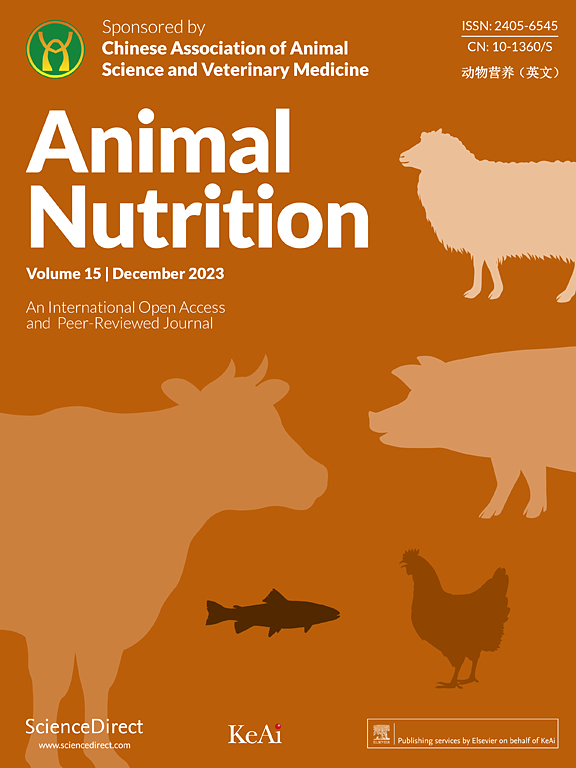氨基酸在肉仔鸡寿命中的消耗
IF 6.1
1区 农林科学
Q1 AGRICULTURE, DAIRY & ANIMAL SCIENCE
引用次数: 0
摘要
在孵化后42天,肉鸡胴体中产生1.0 kg蛋白质需要摄入约2.5 kg的饲粮蛋白质,这反映了在其生命周期中发生的饲粮氨基酸消耗或浪费。因此,本综述的目的是研究肉鸡对氨基酸的利用,因为识别和纠正任何可避免的损失将有利于鸡肉行业和消费者。氨基酸在通过肠细胞转化为消化过程所需的能量生产时,会丢失到分解代谢途径中。然而,缓慢消化的淀粉已被证明通过提供更多的葡萄糖作为替代能量底物而使氨基酸免于分解代谢损失;这种潜在的好处值得进一步调查。蛋白质周转可能是氨基酸消耗的更大来源,但这是一个复杂的领域。蛋白质周转是指蛋白质沉积和降解之间的动态平衡,正平衡表明净蛋白质合成和生长。全身血浆中的3-甲基组氨酸浓度可能是蛋白质降解的一个足够准确的指标,它可能是蛋白质周转中更有影响力的成分。如果能证明这一点,涉及左旋肉碱和3-甲基组氨酸的实验可能会证明非常有指导意义,因为有迹象表明,左旋肉碱具有抑制肉仔鸡蛋白质降解和提高蛋白质周转的能力。胰岛素在禽类中的功能本质上是一个难题,特别是在肉鸡成熟时,它对蛋白质周转的调节作用,理想情况下,这应该得到阐明。重要的是,营养学家应继续努力为肉鸡制定准确满足氨基酸需求的日粮。当实现这一目标时,肠内氨基酸失衡引起的循环氨水平将受到限制,有利于蛋白质周转和肉鸡的生长性能。在肉鸡饲粮中,蛋白质结合体和非结合体之间的适当平衡、理想的氨基酸比例和较高的饲粮电解质平衡可能会减弱蛋白质的降解。本文章由计算机程序翻译,如有差异,请以英文原文为准。
Attrition of amino acids in the life span of broiler chickens
A dietary protein intake of approximately 2.5 kg is required to generate 1.0 kg of protein in the carcass of broiler chickens at 42 d post-hatch, reflecting the attrition or wastage of dietary amino acids that occurs during their lifespan. Thus, the aim of this review is to examine amino acid utilisation in broilers because the identification and correction of any avoidable losses will advantage both the chicken meat industry and consumers. Amino acids are lost to catabolic pathways in their transition across the enterocytes for energy production required for digestive processes. However, slowly digestible starch has been indicated to spare amino acids from catabolic losses by providing more glucose as an alternative energy substrate; this potential benefit warrants further investigation. Protein turnover may represent an even greater source of amino acid attrition, but it is a complex area. Protein turnover refers to the dynamic equilibrium between protein deposition and degradation, with a positive balance indicating net protein synthesis and growth. 3-methylhistidine concentrations in systemic plasma may be a sufficiently accurate indicator of protein degradation, which is probably the more influential component in protein turnover. If this can be demonstrated, experiments involving both L-carnitine and 3-methylhistidine may prove highly instructive because there are indications that L-carnitine has the capacity to depress protein degradation and enhance protein turnover in broiler chickens. The function of insulin in avian species is essentially a conundrum, particularly in relation to its regulatory role over protein turnover as broilers mature, and, ideally, this should be elucidated. Importantly, nutritionists should continue to endeavour to formulate diets for broiler chickens that meet amino acid requirements accurately. When this is achieved, circulating ammonia levels arising from post-enteral amino acid imbalances will be limited to the advantage of protein turnover and broiler growth performance. It is possible that protein degradation would be attenuated by broiler diets with appropriate balances between protein-bound and non-bound entities, ideal amino acid ratios and higher dietary electrolyte balances.
求助全文
通过发布文献求助,成功后即可免费获取论文全文。
去求助
来源期刊

Animal Nutrition
Agricultural and Biological Sciences-Animal Science and Zoology
CiteScore
7.40
自引率
3.20%
发文量
172
审稿时长
12 weeks
期刊介绍:
Animal Nutrition encompasses the full gamut of animal nutritional sciences and reviews including, but not limited to, fundamental aspects of animal nutrition such as nutritional requirements, metabolic studies, body composition, energetics, immunology, neuroscience, microbiology, genetics and molecular and cell biology related to nutrition, and more applied aspects of animal nutrition, such as raw material evaluation, feed additives, nutritive value of novel ingredients and feed safety.
 求助内容:
求助内容: 应助结果提醒方式:
应助结果提醒方式:


